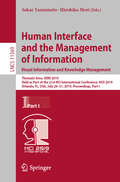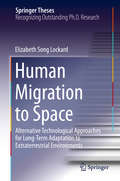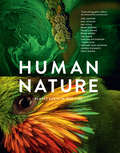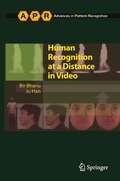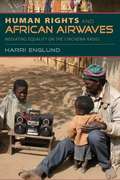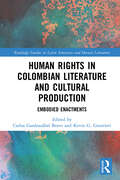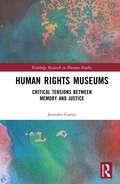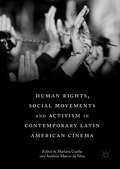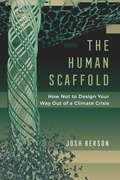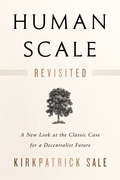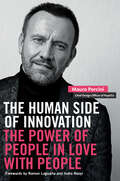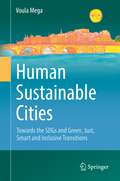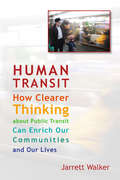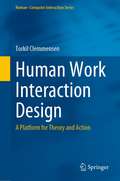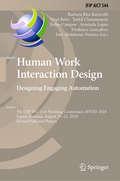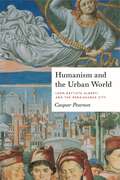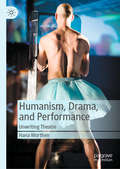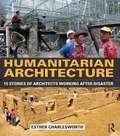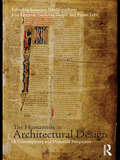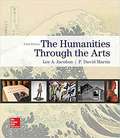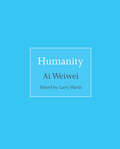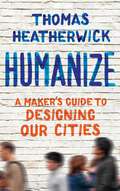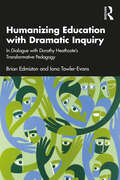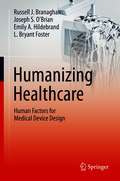- Table View
- List View
Human Interface and the Management of Information. Visual Information and Knowledge Management: Thematic Area, HIMI 2019, Held as Part of the 21st HCI International Conference, HCII 2019, Orlando, FL, USA, July 26–31, 2019, Proceedings, Part I (Lecture Notes in Computer Science #11569)
by Sakae Yamamoto Hirohiko MoriThis two-volume set LNCS 11569 and 11570 constitutes the refereed proceedings of the Thematic Area on Human Interface and the Management of Information, HIMI 2019, held as part of HCI International 2019 in Orlando, FL, USA.HCII 2019 received a total of 5029 submissions, of which 1275 papers and 209 posters were accepted for publication after a careful reviewing process. The 91 papers presented in the two volumes were organized in topical sections named: Visual information; Data visualization and analytics; Information, cognition and learning; Information, empathy and persuasion; Knowledge management and sharing; Haptic and tactile interaction; Information in virtual and augmented reality; Machine learning and intelligent systems; Human motion and expression recognition and tracking; Medicine, healthcare and quality of life applications.
Human Migration to Space
by Elizabeth Song LockardHuman migration to space will be the most profound catalyst for evolution in the history of humankind, yet this has had little impact on determining our strategies for this next phase of exploration. Habitation in space will require extensive technological interfaces between humans and their alien surroundings and how they are deployed will critically inform the processes of adaptation. As humans begin to spend longer durations in space--eventually establishing permanent outposts on other planets--the scope of technological design considerations must expand beyond the meager requirements for survival to include issues not only of comfort and well‐being, but also of engagement and negotiation with the new planetary environment that will be crucial to our longevity beyond Earth. Approaching this question from an interdisciplinary approach, this dissertation explores how the impact of interior space architecture can meet both the physical and psychological needs of future space colonists and set the stage for humankind to thrive and grow while setting down new roots beyond Earth.
Human Nature: Planet Earth In Our Time: Twelve Photographers Address the Future of the Environment
by Geoff Blackwell Ruth HobdayIn Human Nature, 12 of today's most influential nature and conservation photographers address the biggest environmental concerns of our time.• Joel Sartore• Paul Nicklen• Ami Vitale• Brent Stirton• Frans Lanting• Brian Skerry• Tim Laman• Cristina Mittermeier• J Henry Fair• Richard John Seymour• George Steinmetz• Steve WinterAlongside their reflections, they present curated selections from their photographic careers. Stories and extraordinary images from around the world come together in a powerful call to awareness and action.• The United Nations has declared that nature is in more trouble now than at any other time in human history.• Extinction looms over one million species of plants and animals.• Human Nature wrestles with challenging questions: What do we have? What do we stand to lose?This book offers inspiration to environmentalists, activists, photography fans, and anyone concerned about the future of our world.• This illuminating book tackles our modern environmental future through the lens of preeminent photographers• Great gift for photographers, nature enthusiasts, those who enjoy backpacking and camping, and anyone who cares about Earth's climate and future• Add it to the shelf with books like National Geographic The Photo Ark Vanishing: The World's Most Vulnerable Animals by Joel Sartore, The Sixth Extinction: An Unnatural History by Elizabeth Kolbert, and Dire Predictions: The Visual Guide to the Findings of the IPCC by Michael E. Mann and Lee R. Kump.
Human Recognition at a Distance in Video
by Bir Bhanu Ju HanMost biometric systems employed for human recognition require physical contact with, or close proximity to, a cooperative subject. Far more challenging is the ability to reliably recognize individuals at a distance, when viewed from an arbitrary angle under real-world environmental conditions. Gait and face data are the two biometrics that can be most easily captured from a distance using a video camera. This comprehensive and logically organized text/reference addresses the fundamental problems associated with gait and face-based human recognition, from color and infrared video data that are acquired from a distance. It examines both model-free and model-based approaches to gait-based human recognition, including newly developed techniques where the both the model and the data (obtained from multiple cameras) are in 3D. In addition, the work considers new video-based techniques for face profile recognition, and for the super-resolution of facial imagery obtained at different angles. Finally, the book investigates integrated systems that detect and fuse both gait and face biometrics from video data. Topics and features: discusses a framework for human gait analysis based on Gait Energy Image, a spatio-temporal gait representation; evaluates the discriminating power of model-based gait features using Bayesian statistical analysis; examines methods for human recognition using 3D gait biometrics, and for moving-human detection using both color and thermal image sequences; describes approaches for the integration face profile and gait biometrics, and for super-resolution of frontal and side-view face images; introduces an objective non-reference quality evaluation algorithm for super-resolved images; presents performance comparisons between different biometrics and different fusion methods for integrating gait and super-resolved face from video. This unique and authoritative text is an invaluable resource for researchers and graduate students of computer vision, pattern recognition and biometrics. The book will also be of great interest to professional engineers of biometric systems.
Human Rights and African Airwaves: Mediating Equality on the Chichewa Radio
by Harri EnglundHuman Rights and African Airwaves focuses on Nkhani Zam'maboma, a popular Chichewa news bulletin broadcast on Malawi's public radio. The program often takes authorities to task and questions much of the human rights rhetoric that comes from international organizations. Highlighting obligation and mutual dependence, the program expresses, in popular idioms and local narrative forms, grievances and injustices that are closest to Malawi's impoverished public. Harri Englund reveals broadcasters' everyday struggles with state-sponsored biases and a listening public with strong views and a critical ear. This fresh look at African-language media shows how Africans effectively confront inequality, exploitation, and poverty.
Human Rights in Colombian Literature and Cultural Production: Embodied Enactments (Routledge Studies in Latin American and Iberian Literature)
by Carlos Gardeazábal BravoThis volume explores how Colombian novelists, artists, performers, activists, musicians, and others seek to enact—to perform, to stage, to represent—human rights situations that are otherwise enacted discursively, that is, made public or official, in juridical and political realms in which justice often remains an illusory or promised future. In order to probe how cultural production embodies the tensions between the abstract universality of human rights and the materiality of violations on individual human bodies and on determined groups, the volume asks the following questions: How does the transmission of historical traumas of Colombia’s past, through human rights narratives in various forms, inform the debates around the subjects of rights, truth and memory, remembrance and forgetting, and the construction of citizenship through solidarity and collective struggles for justice? What are the different roles taken by cultural products in the interstices among rights, laws, and social justice within different contexts of state violence and states of exception? What are alternative perspectives, sources, and (micro)histories from Colombia of the creation, evolution, and practice of human rights? How does the human rights discourse interface with notions of environmental justice, especially in the face of global climate change, regional (neo)extractivism, the implementation of megaprojects, and ongoing post-accord thefts and (re)appropriations of land? Through a wide range of disciplinary lenses, the different chapters explore counter-hegemonic concepts of human rights, decolonial options struggling against oppression and market logic, and alternative discourses of human dignity and emancipation within the pluriverse.
Human Rights Museums: Critical Tensions Between Memory and Justice (Routledge Research in Museum Studies)
by Jennifer CarterHuman Rights Museums presents case studies that trace how calls for historical and social justice, and the commensurate rise of a rights regime have led to the emergence of a new museological genre: the human rights museum. Presenting innovative field research conducted in new and emerging human rights museums across Asia and Latin America, the book adopts a broad museological approach. It does so by including national and community museums, as well as public and private museological initiatives, within its purview. Drawing on in-depth case studies about museums in Taiwan, Japan, Paraguay and Colombia – all discussed within their political and cultural contexts – the book examines the paradigmatic shift that has occurred within the museum field in the wake of the larger global transformations that have shaped contemporary geo-politics over the last 50 years. The diversity of geographical and political contexts, and the attention to lesser-known institutions within the canon of English museum studies literature, presents readers with a valuable opportunity to learn more about innovative museological models in non-English-speaking and non-Western contexts. Human Rights Museums will appeal to academics, scholars and students of museum studies and related disciplines, and to museum professionals seeking to know more about the diverse and evolving roles of museums in contemporary society.
Human Rights, Social Movements and Activism in Contemporary Latin American Cinema
by Mariana Cunha Antônio Márcio da SilvaThis edited collection explores how contemporary Latin American cinema has dealt with and represented issues of human rights, moving beyond many of the recurring topics for Latin American films. Through diverse interdisciplinary theoretical and methodological approaches, and analyses of different audiovisual media from fictional and documentary films to digitally-distributed activist films, the contributions discuss the theme of human rights in cinema in connection to various topics and concepts. Chapters in the volume explore the prison system, state violence, the Mexican dirty war, the Chilean dictatorship, debt, transnational finance, indigenous rights, social movement, urban occupation, the right to housing, intersectionality, LGBTT and women’s rights in the context of a number of Latin American countries. By so doing, it assesses the long overdue relation between cinema and human rights in the region, thus opening new avenues to aid the understanding of cinema’s role in social transformation.
The Human Scaffold: How Not to Design Your Way Out of a Climate Crisis (Great Transformations #2)
by Josh BersonHumanity has precipitated a planetary crisis of resource consumption—a crisis of stuff. So ingrained is our stuff-centric view that we can barely imagine a way out beyond substituting a new portmanteau of material things for the one we have today.In The Human Scaffold, anthropologist Josh Berson offers a new theory of adaptation to environmental change. Drawing on niche construction, evolutionary game theory, and the enactive view of cognition, Berson considers cases in the archaeology of adaptation in which technology in the conventional sense was virtually absent. Far from representing anomalies, these cases exemplify an enduring feature of human behavior that has implications for our own fate.The time has come to ask what the environmental crisis demands of us not as consumers but as biological beings. The Human Scaffold offers a starting point.
Human Scale Revisited: A New Look at the Classic Case for a Decentralist Future
by Kirkpatrick SaleBig government, big business, big everything: Kirkpatrick Sale took giantism to task in his 1980 classic, Human Scale, and today takes a new look at how the crises that imperil modern America are the inevitable result of bigness grown out of control—and what can be done about it. The result is a keenly updated, carefully argued case for bringing human endeavors back to scales we can comprehend and manage—whether in our built environments, our politics, our business endeavors, our energy plans, or our mobility. Sale walks readers back through history to a time when buildings were scaled to the human figure (as was the Parthenon), democracies were scaled to the societies they served, and enterprise was scaled to communities. Against that backdrop, he dissects the bigger-is-better paradigm that has defined modern times and brought civilization to a crisis point. Says Sale, retreating from our calamity will take rebalancing our relationship to the environment; adopting more human-scale technologies; right-sizing our buildings, communities, and cities; and bringing our critical services—from energy, food, and garbage collection to transportation, health, and education—back to human scale as well. Like Small is Beautiful by E. F. Schumacher, Human Scale has long been a classic of modern decentralist thought and communitarian values—a key tool in the kit of those trying to localize, create meaningful governance in bioregions, or rethink our reverence of and dependence on growth, financially and otherwise. Rewritten to interpret the past few decades, Human Scale offers compelling new insights on how to turn away from the giantism that has caused escalating ecological distress and inequality, dysfunctional governments, and unending warfare and shines a light on many possible pathways that could allow us to scale down, survive, and thrive.
The Human Side of Innovation: The Power of People in Love with People
by Mauro PorciniPepsiCo's award-winning chief design officer reveals the secret to creating life-changing innovations: putting human needs at the center of any design process.&“Innovation is an act of love-or at least it should be. Always. It is a gesture of empathy, respect, generosity, of one human being's devotion to another,&” writes Mauro Porcini at the beginning of this extraordinary book. It is in part a memoir by one of the world's leading designers-the first chief design officer at both 3M and Pepsi. But even more, it is a manifesto for a genuine, authentic, and deeply humanistic approach to design, one that aims to create personal and social value first and financial and economic value afterward. In every industry, new technologies have lowered the barrier to entry like never before. Either you design exceptional products or somebody will beat you to it. Porcini shows, through example after example and story after story, that the key to real, world-changing innovation is to put people first-not only the people we innovate for but also the people who lead the innovation process.Putting people first requires what Porcini calls unicorns: people who are in love with people, who have a genuine fire in them to create meaningful solutions for actual human beings. In this book, he describes them, celebrates them, and details their superpowers so you can find them, hire them, grow them, and retain them. Some are qualities you might expect-the ability to dream combined with the ability to execute. But when was the last time you heard an executive ask prospective hires if they were kind, optimistic, curious, or humble? Porcini uses his journey across startups and multinational corporations, through successes and failures, to create a handbook for modern innovators.
Human Sustainable Cities: Towards the SDGs and Green, Just, Smart and Inclusive Transitions
by Voula MegaThis book argues that accelerating action toward sustainability for and by cities and their inhabitants can make a huge difference to humanity’s endeavor to recover from current crises and build a sustainable future. It sheds light on cutting-edge concepts and actions toward sustainability that can taken by and for cities and with citizens. In this book, author Voula Mega takes the reader on a journey inside and across cities and highlights efforts toward a paradigmatic shift that reconciles human systems with nature. Leadership, education, innovation, trust and citizen empowerment all play a crucial role for the co-invention of a new model that balances human well-being, sustainable prosperity and the future of the planet. Building on robust evidence and inspired by best practices, Human Sustainable Cities offers compelling messages and convincing advice to all stakeholders who are striving to overcome crises, speed up the path toward resilience and preparedness and bounce forward better.
Human Transit: How Clearer Thinking about Public Transit Can Enrich Our Communities and Our Lives
by Jarrett WalkerPublic transit is a powerful tool for addressing a huge range of urban problems, including traffic congestion and economic development as well as climate change. But while many people support transit in the abstract, it's often hard to channel that support into good transit investments. Part of the problem is that transit debates attract many kinds of experts, who often talk past each other. Ordinary people listen to a little of this and decide that transit is impossible to figure out. Jarrett Walker believes that transit can be simple, if we focus first on the underlying geometry that all transit technologies share. In Human Transit, Walker supplies the basic tools, the critical questions, and the means to make smarter decisions about designing and implementing transit services. Human Transit explains the fundamental geometry of transit that shapes successful systems; the process for fitting technology to a particular community; and the local choices that lead to transit-friendly development. Whether you are in the field or simply a concerned citizen, here is an accessible guide to achieving successful public transit that will enrich any community.
Human Work Interaction Design: A Platform for Theory and Action (Human–Computer Interaction Series)
by Torkil ClemmensenAn approach to socio-technical HCI called Human Work Interaction Design (HWID) emerged around 2005. It has grown steadily, and now is the time for sharing this research with a wider audience. In this book, the HWID approach is used to discuss socio-technical HCI theory, cases, methods, and impact. The book introduces HWID as a multi-sided platform for theorizing about socio-technical HCI work design in the digital age. It presents design cases that illustrate the design of socio-technical relations, provides specific advice for researchers, consultants, and policy makers, and reflects on the open issues related to theorizing about sociotechnical HCI. The benefits of HWID include that it meets the requirement of taking both the social and the technical into account, while focusing strongly on the relationship between the social and the technical. In addition, it is truly international and explicitly considers local cultural, organizational, and technological contexts.
Human Work Interaction Design. Designing Engaging Automation: 5th IFIP WG 13.6 Working Conference, HWID 2018, Espoo, Finland, August 20 - 21, 2018, Revised Selected Papers (IFIP Advances in Information and Communication Technology #544)
by Barbara Rita Barricelli Virpi Roto Torkil Clemmensen Pedro Campos Arminda Lopes Frederica Gonçalves José Abdelnour-NoceraThis book constitutes the thoroughly refereed post-conference proceedings of the 5th IFIP WG 13.6 Working Conference on Human Work Interaction Design, HWID 2018, held in Espoo, Finland, in August 2018.The 19 revised and extended full papers presented were carefully selected for inclusion in this volume. The papers deal with the analysis and interaction design of a variety of complex work and life contexts found in different business and application domains. They focus on interaction design for work engagement taking usability of interactive systems to the next level by providing employees pleasurable and meaningful experiences via the tools used at work. The papers are organized in two sections: the first section presents cases of HWID in practice, while the second one focuses on methodological discussion.
Humanism and the Urban World: Leon Battista Alberti and the Renaissance City
by Caspar PearsonIn Humanism and the Urban World, Caspar Pearson offers a profoundly revisionist account of Leon Battista Alberti’s approach to the urban environment as exemplified in the extensive theoretical treatise De re aedificatoria (On the Art of Building in Ten Books), brought mostly to completion in the 1450s, as well as in his larger body of written work. Past scholars have generally characterized the Italian Renaissance architect and theorist as an enthusiast of the city who envisioned it as a rational, Renaissance ideal. Pearson argues, however, that Alberti’s approach to urbanism was far more complex—that he was even “essentially hostile” to the city at times. Rather than proposing the “ideal” city, Pearson maintains, Alberti presented a variety of possible cities, each one different from another. This book explores the ways in which Alberti sought to remedy urban problems, tracing key themes that manifest in De re aedificatoria. Chapters address Alberti’s consideration of the city’s possible destruction and the city’s capacity to provide order despite its intrinsic instability; his assessment of a variety of political solutions to that instability; his affinity for the countryside and discussions of the virtues of the active versus the contemplative life; and his theories of aesthetics and beauty, in particular the belief that beauty may affect the soul of an enemy and thus preserve buildings from attack.
Humanism, Drama, and Performance: Unwriting Theatre
by Hana WorthenThis book examines the appropriation of theatre and theatrical performance by ideologies of humanism, in terms that continue to echo across the related disciplines of literary, drama, theatre, and performance history and studies today. From Aristotle onward, theatre has been regulated by three strains of critical poiesis: the literary, segregating theatre and the practices of the spectacular from the humanizing work attributed to the book and to the internality of reading; the dramatic, approving the address of theatrical performance only to the extent that it instrumentalizes literary value; and the theatrical, assimilating performance to the conjunction of literary and liberal values. These values have been used to figure not only the work of theatre, but also the propriety of the audience as a figure for its socializing work, along a privileged dualism from the aestheticized ensemble—harmonizing actor, character, and spectator to the essentialized drama—to the politicized assembly, theatre understood as an agonistic gathering.
Humanitarian Architecture: 15 stories of architects working after disaster
by Esther CharlesworthNever has the demand been so urgent for architects to respond to the design and planning challenges of rebuilding post-disaster sites and cities. In 2011, more people were displaced by natural disasters (42 million) than by wars and armed conflicts. And yet the number of architects equipped to deal with rebuilding the aftermath of these floods, fires, earthquake, typhoons and tsunamis is chronically short. This book documents and analyses the expanding role for architects in designing projects for communities after the event of a natural disaster. The fifteen case studies featured in the body of the book illustrate how architects can use spatial sensibility and integrated problem-solving skills to help alleviate both human and natural disasters. The cases include: Lizzie Babister - Department of International Development, UK. Shigeru Ban - Winner of The Pritzker Architecture Prize 2014, Shigeru Ban Architects and Voluntary Architects’ Network, Japan. Eric Cesal – Disaster Reconstruction and Resiliency Studio and Architecture for Humanity, Japan. Hsieh Ying Chun – Atelier 3, Taiwan. Nathaniel Corum - Education Outreach and Architecture for Humanity, USA. Sandra D’Urzo - Shelter and Settlements and International Federation of the Red Cross and Red Crescent Societies, Switzerland. Brett Moore - World Vision International, Australia. Michael Murphy - MASS Design Group, USA. David Perkes - Gulf Coast Community Design Studio, USA. Paul Pholeros - Healthabitat, Australia. Patama Roonrakwit - Community Architects for Shelter and Environment, Thailand. Graham Saunders - International Federation of Red Cross and Red Crescent Societies, Switzerland. Kirtee Shah - Ahmedabad Study Action Group, India. Maggie Stephenson - UN-HABITAT, Haiti. Anna Wachtmeister - Catholic Organisation for Relief and Redevelopment Aid, the Netherlands. The interviews and supporting essays show built environment professionals collaborating with post-disaster communities as facilitators, collaborators and negotiators of land, space and shelter, rather than as ‘save the world’ modernists, as often portrayed in the design media. The goal is social and physical reconstruction, as a collaborative process involving a damaged community and its local culture, environment and economy; not just shelter ‘projects’ that ‘build’ houses but leave no economic footprint or longer-term community infrastructure. What defines and unites the architects interviewed for Humanitarian Architecture is their collective belief that through a consultative process of spatial problem solving, the design profession can contribute in a significant way to the complex post-disaster challenge of rebuilding a city and its community.
Humanitarian Photography
by Heide Fehrenbach Davide RodognoFor well over a century, humanitarians and their organizations have used photographic imagery and the latest media technologies to raise public awareness and funds to alleviate human suffering. This volume examines the historical evolution of what we today call "humanitarian photography" - the mobilization of photography in the service of humanitarian initiatives across state boundaries - and asks how we can account for the shift from the fitful and debated use of photography for humanitarian purposes in the late nineteenth century to our current situation in which photographers market themselves as "humanitarian photographers." This book is the first to investigate how humanitarian photography emerged and how it operated in diverse political, institutional, and social contexts, bringing together more than a dozen scholars working on the history of humanitarianism, international organizations and nongovernmental organizations, and visual culture in Africa, Asia, the Middle East, Europe, and the United States. Based on original archival research and informed by current historical and theoretical approaches, the chapters explore the history of the mobilization of images and emotions in the globalization of humanitarian agendas up to the present.
The Humanities in Architectural Design: A Contemporary and Historical Perspective
by Soumyen BandyopadhyayOffering an in-depth consideration of the impact which humanities have had on the processes of architecture and design, this book asks how we can restore the traditional dialogue between intellectual enquiry in the humanities and design creativity. Written by leading academics in the fields of history, theory and philosophy of design, these essays draw profound meanings from cultural practices and beliefs. These are as diverse as the designs they inspire and include religious, mythic, poetic, political, and philosophical references. This timely and important book is not a benign reflection on humanities' role in architectural design but a direct response to the increased marginalization of humanities in a technology driven world. The prioritization of technology leaves critical questions unanswered about the relationships between information and knowledge, transcription and translation, and how emerging technologies can usefully contribute to a deeper understanding of our design culture.
Humanities through the Arts
by F. David MartinHumanities Through the Arts tenth edition continues to explore the humanities with an emphasis upon the arts as an expression of cultural and personal values examining the relationship of the humanities to important values objects and events. The book is arranged topically by art form from painting sculpture photography and architecture to literature music theater film and dance. <P><P>Four major pedagogical boxed features enhance student understanding of the genres and of individual works within the genres: Perception Key boxes Conception Key boxes Experiencing boxes and new Focus On boxes. Intended for introductory-level interdisciplinary courses offered across the curriculum in the Humanities Philosophy Art English Music and Education departments this beautifully illustrated text helps students learn how to actively engage a work of art.
Humanity
by Larry Warsh Weiwei AiWritings on human life and the refugee crisis by the most important political artist of our timeAi Weiwei (b. 1957) is widely known as an artist across media: sculpture, installation, photography, performance, and architecture. He is also one of the world's most important artist-activists and a powerful documentary filmmaker. His work and art call attention to attacks on democracy and free speech, abuses of human rights, and human displacement--often on an epic, international scale.This collection of quotations demonstrates the range of Ai Weiwei's thinking on humanity and mass migration, issues that have occupied him for decades. Selected from articles, interviews, and conversations, Ai Weiwei's words speak to the profound urgency of the global refugee crisis, the resilience and vulnerability of the human condition, and the role of art in providing a voice for the voiceless.Select quotations from the book:"This problem has such a long history, a human history. We are all refugees somehow, somewhere, and at some moment.""Allowing borders to determine your thinking is incompatible with the modern era." "Art is about aesthetics, about morals, about our beliefs in humanity. Without that there is simply no art." "I don't care what all people think. My work belongs to the people who have no voice."
Humanize: A Maker's Guide to Designing Our Cities
by Thomas HeatherwickFrom one of the world&’s most innovative designers comes a fiercely passionate manifesto on why so many places have become miserable and boring and how we can make them better for everyone—featuring hundreds of photographs and illustrations that will change how you see the world around you.We are living through a global catastrophe. Buildings affect how we feel, moment by moment, day by day. They have the power to lift us up and make us feel awestruck, playful, safe, and inspired, just as they can make us feel alienated and sad. But many of the places where we live, work, learn, and heal have become monotonous and disposable. We&’re surrounded by cheap, boring buildings that make people stressed, sick, and unhappy. In short, much of our world has been crafted in a way that is hostile to human experience. Now, drawing on his experience of the last thirty years in making bold, beautiful objects and buildings, Thomas Heatherwick offers both an informed critique of the inhumanity in most of today&’s contemporary building design, and a rousing call for action. Looking through Heatherwick&’s eyes, we see familiar landmarks and cityscapes around the world, from London, Paris, Barcelona, Singapore, New York, Vancouver, and beyond, both old and new, famous and obscure, to learn how places can either sap the life out of us—or nourish our senses and our psyche. The time has come, he says, to put emotion back at the heart of the design process, and the reasons to do so could not be more urgent. Design is not superficial: it has an impact upon economics, climate change, our mental and physical wellbeing—even the peace and cohesion of our societies. As citizens and users, we need a world full of architectural diversity that delights and unites us. And as makers and designers, we can help create a world where cities reconnect with their essential mission: to provide human spaces where people mix, meet, inspire each other, and live out their full potential. Elegantly crafted by Heatherwick&’s own studio, and fully illustrated with hundreds of black-and-white photos, Humanize is an urgent call-to-arms for making our world a better place for everyone to live, and provides the vision and tools for us to make it a reality.
Humanizing Education with Dramatic Inquiry: In Dialogue with Dorothy Heathcote’s Transformative Pedagogy
by Brian Edmiston Iona Towler-EvansHumanizing Education with Dramatic Inquiry provides a comprehensive rationale for why and how dramatic inquiry can be used by any teacher to humanize classroom communities and the subject areas being explored with students. Written by teacher educators Brian Edmiston and Iona Towler-Evans, the book re-evaluates the radical humanizing dramatic enquiry pedagogy of British educator Dorothy Heathcote, as developed by the authors in their own teaching using her three approaches: Process Drama, Mantle of the Expert, and the Commission Model. Through scholarly yet practical analysis of extended examples drawn from their own classroom teaching, the volume demonstrates how teachers can collaborate with students of all ages, dispositions, presumed abilities, and cultural backgrounds to transform classroom life into a richly humanizing, curious, inquiring, imaginative community. This book will appeal to educators and teacher educators not only those open to using drama pedagogies in classrooms and in therapy but also to those engaged in applied theatre. Additionally, it will interest those in literacy and education in general who are committed to inclusive, critical, antiracist, anti-oppressive, and artistic practices.
Humanizing Healthcare – Human Factors for Medical Device Design
by Russell J. Branaghan Joseph S. O’Brian Emily A. Hildebrand L. Bryant FosterThis book introduces human factors engineering (HFE) principles, guidelines, and design methods for medical device design. It starts with an overview of physical, perceptual, and cognitive abilities and limitations, and their implications for design. This analysis produces a set of human factors principles that can be applied across many design challenges, which are then applied to guidelines for designing input controls, visual displays, auditory displays (alerts, alarms, warnings), and human-computer interaction. Specific challenges and solutions for various medical device domains, such as robotic surgery, laparoscopic surgery, artificial organs, wearables, continuous glucose monitors and insulin pumps, and reprocessing, are discussed. Human factors research and design methods are provided and integrated into a human factors design lifecycle, and a discussion of regulatory requirements and procedures is provided, including guidance on what human factors activities should be conducted when and how they should be documented.This hands-on professional reference is an essential introduction and resource for students and practitioners in HFE, biomedical engineering, industrial design, graphic design, user-experience design, quality engineering, product management, and regulatory affairs.Teaches readers to design medical devices that are safer, more effective, and less error prone;Explains the role and responsibilities of regulatory agencies in medical device design;Introduces analysis and research methods such as UFMEA, task analysis, heuristic evaluation, and usability testing.
